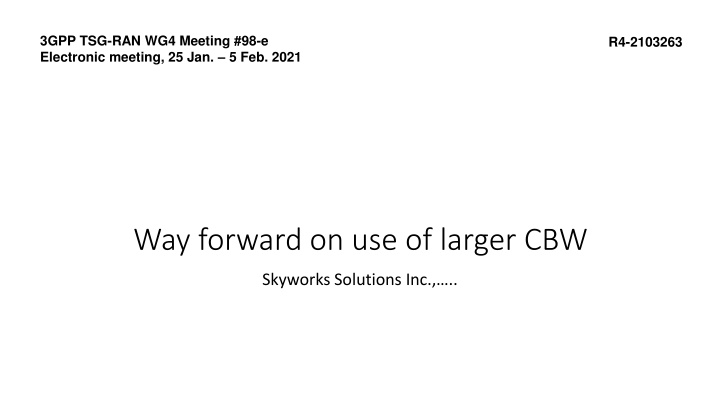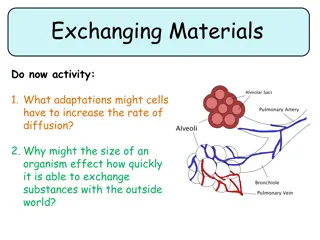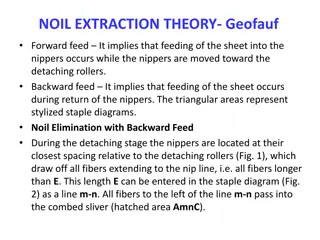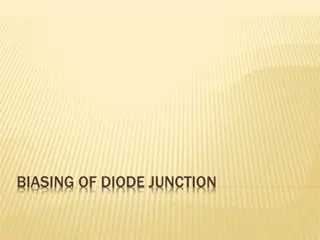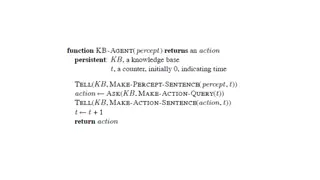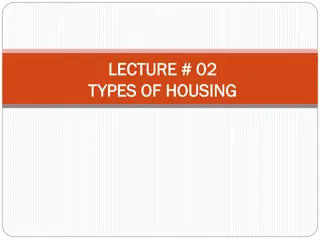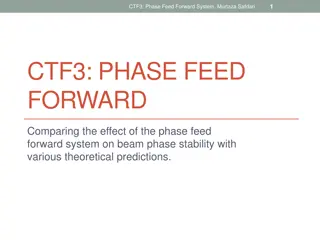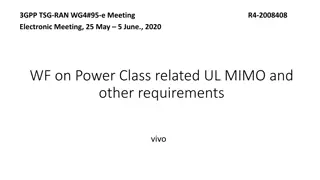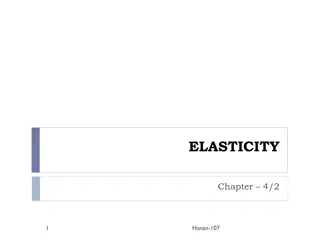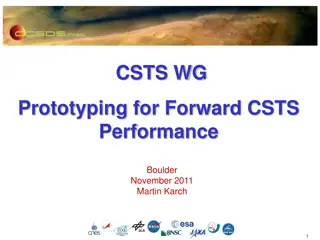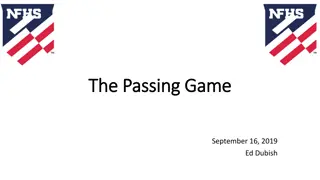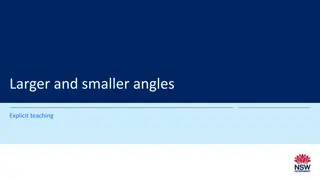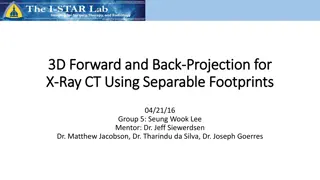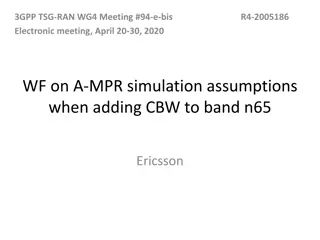Way forward on use of larger CBW
In this electronic meeting, the focus is on the use of larger channel bandwidth, particularly irregular bandwidth, compared to existing standards. Terminology and scope related to irregular bandwidth usage are defined, stressing the importance of compatibility with legacy devices. Legacy UE support with SmallerCHBW overlap is a key consideration, ensuring network perspective support for various UE spectrum assignments. The background emphasizes supporting legacy UEs and utilizing SmallerCHBW or WiderCHBW effectively.
Download Presentation

Please find below an Image/Link to download the presentation.
The content on the website is provided AS IS for your information and personal use only. It may not be sold, licensed, or shared on other websites without obtaining consent from the author.If you encounter any issues during the download, it is possible that the publisher has removed the file from their server.
You are allowed to download the files provided on this website for personal or commercial use, subject to the condition that they are used lawfully. All files are the property of their respective owners.
The content on the website is provided AS IS for your information and personal use only. It may not be sold, licensed, or shared on other websites without obtaining consent from the author.
E N D
Presentation Transcript
3GPP TSG-RAN WG4 Meeting #98-e Electronic meeting, 25 Jan. 5 Feb. 2021 R4-2103263 Way forward on use of larger CBW Skyworks Solutions Inc., ..
Terminology: Irregular bandwidth = IrregularBW a bandwidth that is not a multiple of 5MHz and does not exist in realease 17 Irregular BW may have other restrictions depending on further agreements: For example be a multiple of 1MHz or less than a given BW Existing Immediately lower channel BW = SmallerCHBW Existing release 17 channel bandwidth that is an integer multiple of 5MHz that is closest to the irregular bandwidth but smaller Existing Immediately wider channel BW = WiderCHBW Existing release 17 channel bandwidth that is an integer multiple of 5MHz that is closest to the irregular bandwidth but wider SU for the different irregular BW should be understood as the SU from the network point of view UE and/or BS may not support the SU and only support SU of SmallerCHBW If WiderCHBW is used, used, the maximum allocated RBs is equal to SU but over restrictions may apply
Scope: Define UE, BS and network behavior to be studied for use of existing immediately larger channel BW Clarify applicability to UL and DL Requires that behavior for use of existing SmallerCHBW is understood including legacy UE handling Use of SmallerCHBW or WiderCHBW should be compatible with the support of legacy UEs
Background: Support of legacy UE and use of SmallerCHBW with overlap from network prospective Usage of UE SmallerCHBW with overlap, from network perspective, in order to support legacy UE s Legacy UEs can only be supported with using SmallerCHBW and require that at least one SSB is according to current raster definitions UE using SmallerCHBW can allow the full spectrum (full network SU) use if different UEs are assigned to different side of the spectrum using overlap from network point of view (see picture on next slide). It guaranties that UE UL emissions and regulation are met It guaranties that UE DL receiver performance are known BS may use SmallerCHBW with overlap from network prospective or WiderCHBW Depending on the overlap between the SmallerCHBW the SSB can be common or not
Background: UE using WiderCHBW It is not acceptable that the UE requirements and conformance tests like MPR/AMPR/ACS/blocking are defined every MHz or for any number of RBs and this for any possible band. UE UL emissions and regulation cannot be guaranteed UE DL ACS and blocking performance is unknown Still if adjacent channels are co-located this may not be an issue and thus is worth studying together with selectivity of the FFT RBs and SSB needs to be aligned with legacy UEs and UEs using SmallerCHBW with overlap from network prospective It is not clear whether the BS shall also use WiderCHBW with restricted BWP
WF: UE using WiderCHBW WiderCHBW use for the UE and BS in DL and UL with restricted BWP is further studied It should be compatible with the support of: Legacy UEs using SmallerCHBW in one position compatible with current SSB raster UEs Using SmallerCHBW with overlap from network point of view In UL it is proposed that only SmallerCHBW is used as UL peak throughput is not critical and it guaranties that emissions are met: Legacy UEs use SmallerCHBW in one position compatible with current SSB raster New UEs can use SmallerCHBW with overlap from the network prospective Whether UE and BS both have to support WiderCHBW is FFS
References submitted in this meeting R4-2101556 Utilizing larger bandwidth than the operator licensed bandwidth, Ericsson R4-2101557 Overlapping Channel Bandwidth Approach from UE Perspective, Ericsson R4-2101558 Overlapping Channel Bandwidth Approach from BS Perspective, Ericsson R4-2101959 Discussion on irregular channel bandwidth for NR system, ZTE Corporation R4-2102288 Network and UE options for the support of irregular channel bandwidth, Skyworks Solutions Inc. R4-2102558 On the use of overlapping channel bandwidths from UE perspective, Nokia, Nokia Shanghai Bell R4-2100805 Discussion on overlapping UE channel bandwidths, CMCC R4-2101459 Handling of Channel Bandwidths That Are Not Multiples of 5MHz, Qualcomm Incorporated R4-2101507 Consideration for overlapping UE channel bandwidths, Huawei, HiSilicon R4-2100522 Non-standard spectrum allocations for NR bands, Apple Inc.
